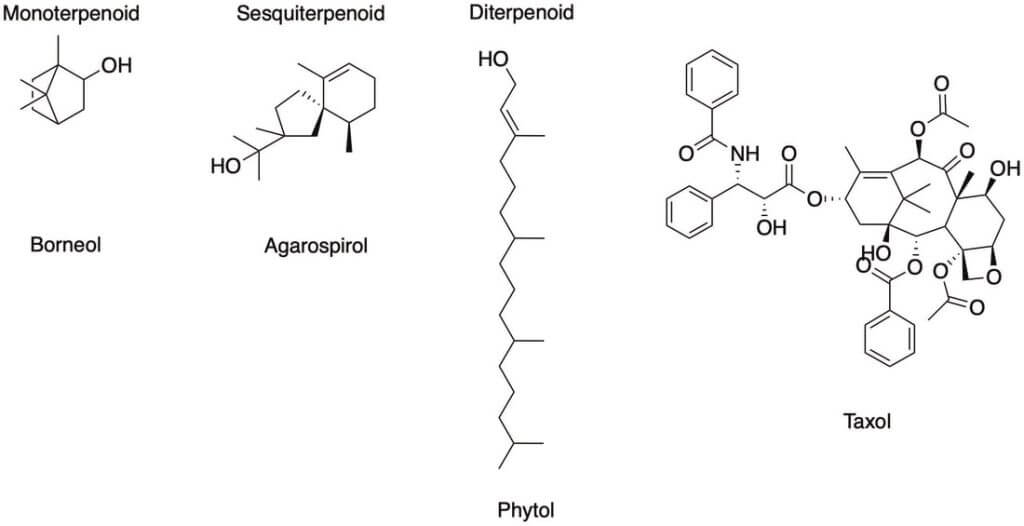
Terpenes vs. Terpenoids
What is the difference between terpenes and terpenoids?
According to our growing database, the presence of over 450 terpenes (and counting!) have been found in cannabis and the chemical structure of many of them is still unknown! Interest in the ability of terpenes to influence the flavours, aromas, and potentially therapeutic effects of cannabis products is growing. This leads to more and more companies offering services like terpene isolation and terpene profiling.
But if you’re preparing to catch the terpene train, you might find that getting into specifics starts to get tricky – terpenes are often called “the future of cannabis” while also confused for terpenoids. We’ve also seen terpenoids called “denatured terpenes”, which is inaccurate. Terpenes and terpenoids are everywhere – in our perfumes, cosmetics, shampoo, food – and they can have vastly different properties[1]. In chemistry, nomenclature can tell you a lot about what properties a molecule has and how specific compounds are structured. Thus, staying informed and critical about the information out there is vital for any producer and that is why it can be very useful to understand how terpenes are named and classified.Let’s start with a little history. The word terpene is usually attributed to the chemist August Kekulé, who was the first to use the term to describe the hydrocarbons found in turpentine as the suffix “ene” illustrates the existence of a carbon-carbon double bound[2], for example ethene (figure 1). Over time this terminology has changed its meaning to address a broader class of compounds. The term terpene is currently used to characterize isoprene-based secondary metabolites[3].

Figure 1 – Terpenes are generally found as part of essential oils. They are usually the dominant elements of rosin and turpentine. They are hydrocarbons which means that they are made up of only carbon and hydrogens. Furthermore, terpenes are built of multiple 5-carbon isoprene units (figure 1). Terpenes are classified according to the number of these 5-carbon units they contain – that’s where terms like “monoterpene”, “sesquiterpene”, and “diterpene” come from, a little counter-intuitively, these are made up of 2, 3, and 4 isoprene units respectively (figure 2). Terpenes are usually desirable in food and pharmaceutical products due to their flavouring and fragrances properties. These compounds usually act on receptors and neurotransmitters [1]. The compounds tend to also mix well with lipids and fats. Limonene (figure 2), a monoterpene, for example, is a commonly used cleaning solvent. Terpenes can also be used in drugs to target malaria [4].

Figure 2 – Terpenoids, on the other hand, are modified terpenes that contain additional elements and functional groups. These functional groups contain oxygen. Terpenoids can be “monoterpenoids”, “sesquiterpenoids” and “diterpenoids”, mimicking the nomenclatura of terpenes (figure 3). Many terpenoids’ variations are biologically active and are used to cure many illnesses. One of the most known terpenoids are used to repress carcinogenic cells and are also components of drugs like Taxol [4].

Figure 3
Based on these differences, the use of the terms terpene and terpenoids interchangeably is incorrect. It is important to understand these differences, especially in the cannabis industry, as many compounds present in the plant are still to be discovered and the database is growing every minute. To understand the plants properties and its possible uses and advantages, a critical and accurate view of the plant’s composition is needed.
References
[1] Medical Jane (2019, 10). Introduction to Terpenes. Retrieved from https://www.medicaljane.com/category/cannabis-classroom/terpenes/#introduction-to-terpenes
[2]McCreath, S. B., & Delgoda, R. (2017;2016;). Pharmacognosy: Fundamentals, applications and strategies. US: Academic Press.
[3]Donnelly, D. (1991). Natural products of woody plants I and II. Phytochemistry, 30(1), 373-374. doi:10.1016/0031-9422(91)84163-M
[4] Perveen, S. (2018, 06). Introductory Chapter: Terpenes and Terpenoids. Retrieved from https://www.intechopen.com/books/terpenes-and-terpenoids/introductory-chapter-terpenes-and-terpenoids

